HI5013 Managing Across Borders: Woolworths' Asian Market Strategy
VerifiedAdded on 2024/06/03
|13
|3843
|244
Report
AI Summary
This report examines Woolworths' strategic expansion into the Asian market, detailing the approaches used for internationalization, the strategies implemented, and the challenges encountered. It begins with an overview of Woolworths, its foundation in 1924, and its growth to become a leading supermarket chain in Australia. The report discusses key internationalization approaches, including building a solid foundation, customer-centric leadership, and prioritizing people. It also analyzes Porter's Five Forces to understand the competitive landscape, addressing threats from new entrants, bargaining power of suppliers and buyers, substitute products, and rivalry among existing competitors. Furthermore, the report elaborates on the strategies Woolworths employs in the international market, such as leveraging e-commerce, capitalizing on economic growth in Asian countries, and utilizing marketing mix strategies (4Ps). Finally, it highlights the challenges Woolworths faces in the Asian market, including cultural differences, regulatory hurdles, and intense competition. This report provides a comprehensive overview of Woolworths' endeavors in the Asian market.
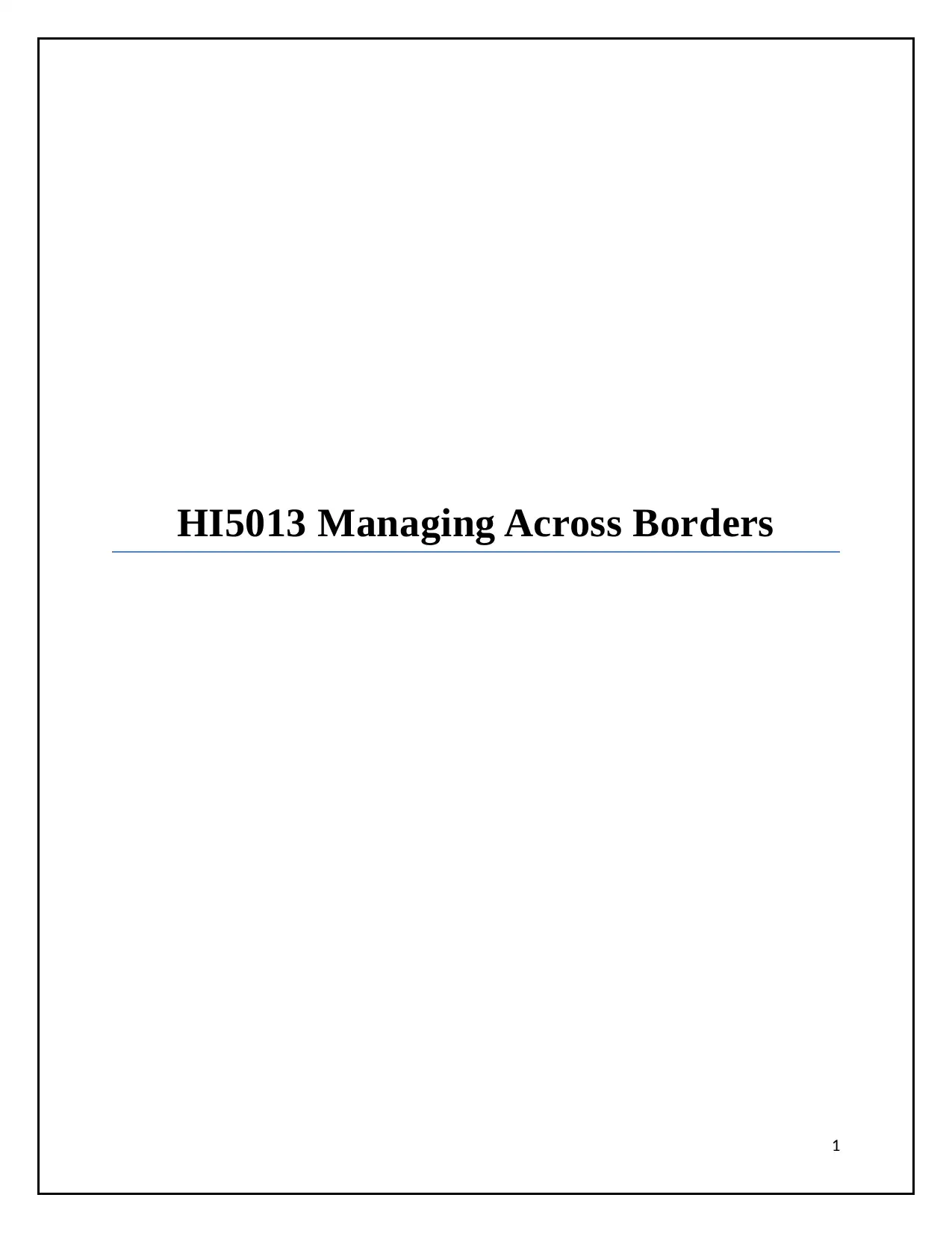
HI5013 Managing Across Borders
1
1
Paraphrase This Document
Need a fresh take? Get an instant paraphrase of this document with our AI Paraphraser
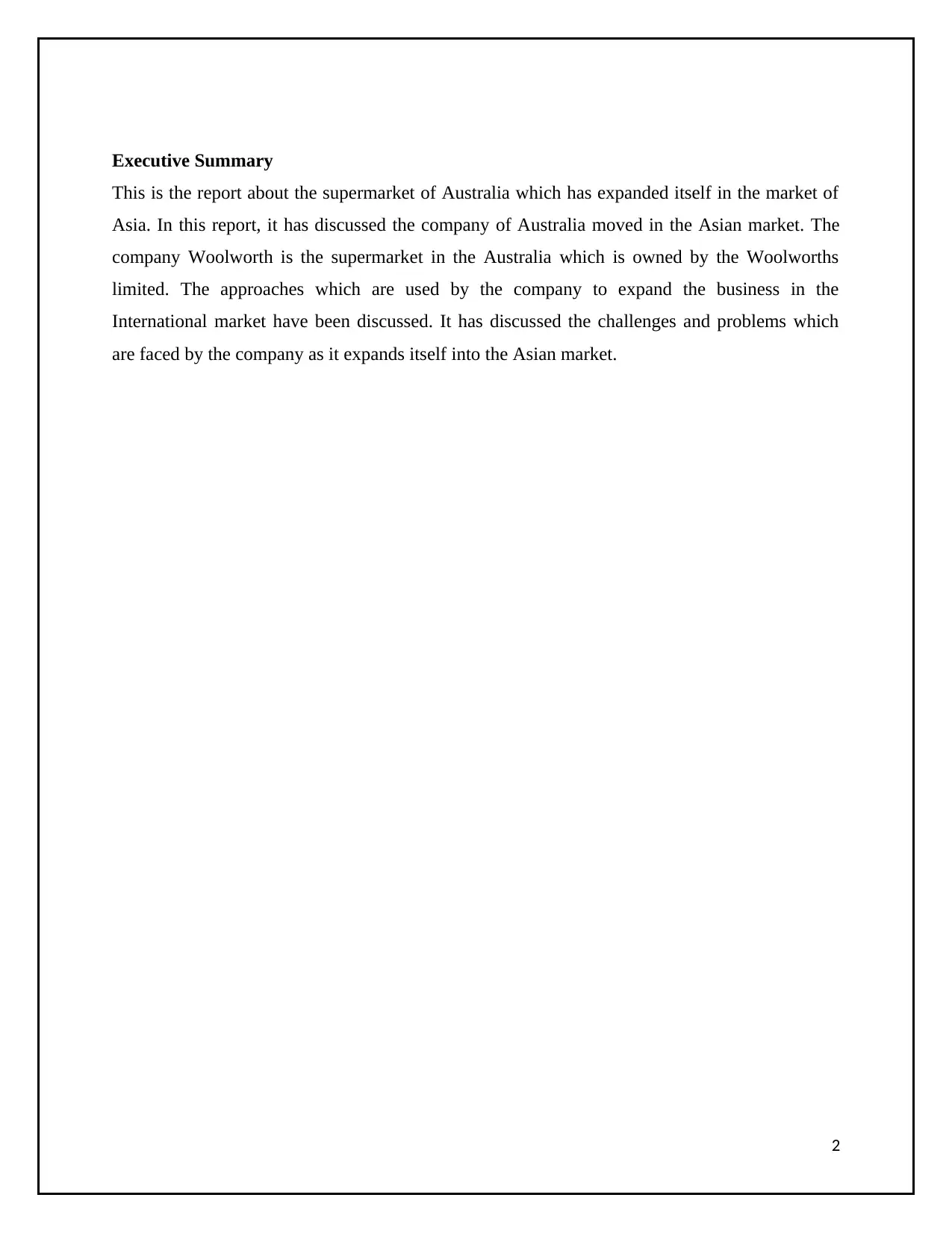
Executive Summary
This is the report about the supermarket of Australia which has expanded itself in the market of
Asia. In this report, it has discussed the company of Australia moved in the Asian market. The
company Woolworth is the supermarket in the Australia which is owned by the Woolworths
limited. The approaches which are used by the company to expand the business in the
International market have been discussed. It has discussed the challenges and problems which
are faced by the company as it expands itself into the Asian market.
2
This is the report about the supermarket of Australia which has expanded itself in the market of
Asia. In this report, it has discussed the company of Australia moved in the Asian market. The
company Woolworth is the supermarket in the Australia which is owned by the Woolworths
limited. The approaches which are used by the company to expand the business in the
International market have been discussed. It has discussed the challenges and problems which
are faced by the company as it expands itself into the Asian market.
2
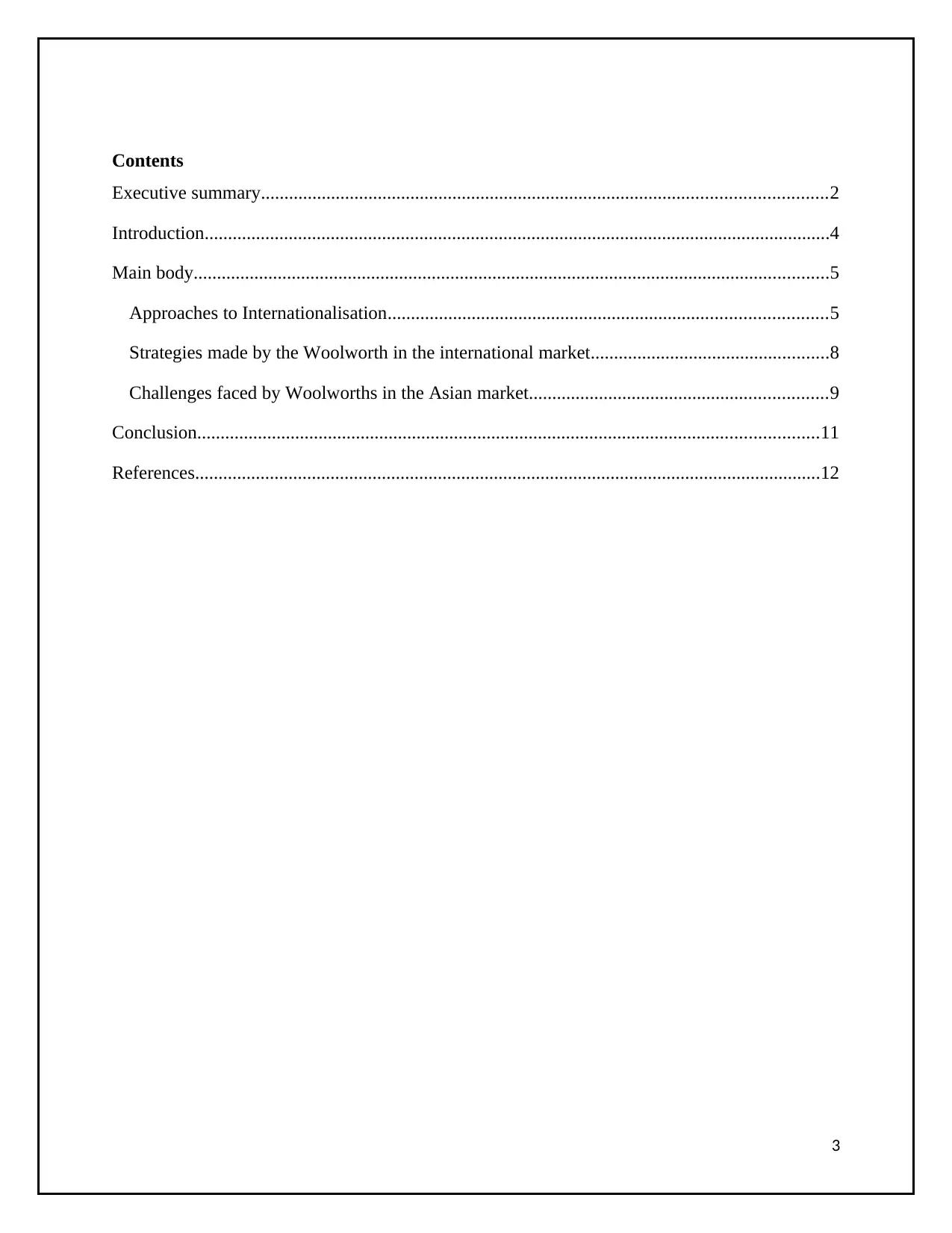
Contents
Executive summary.........................................................................................................................2
Introduction......................................................................................................................................4
Main body........................................................................................................................................5
Approaches to Internationalisation..............................................................................................5
Strategies made by the Woolworth in the international market...................................................8
Challenges faced by Woolworths in the Asian market................................................................9
Conclusion.....................................................................................................................................11
References......................................................................................................................................12
3
Executive summary.........................................................................................................................2
Introduction......................................................................................................................................4
Main body........................................................................................................................................5
Approaches to Internationalisation..............................................................................................5
Strategies made by the Woolworth in the international market...................................................8
Challenges faced by Woolworths in the Asian market................................................................9
Conclusion.....................................................................................................................................11
References......................................................................................................................................12
3
⊘ This is a preview!⊘
Do you want full access?
Subscribe today to unlock all pages.

Trusted by 1+ million students worldwide
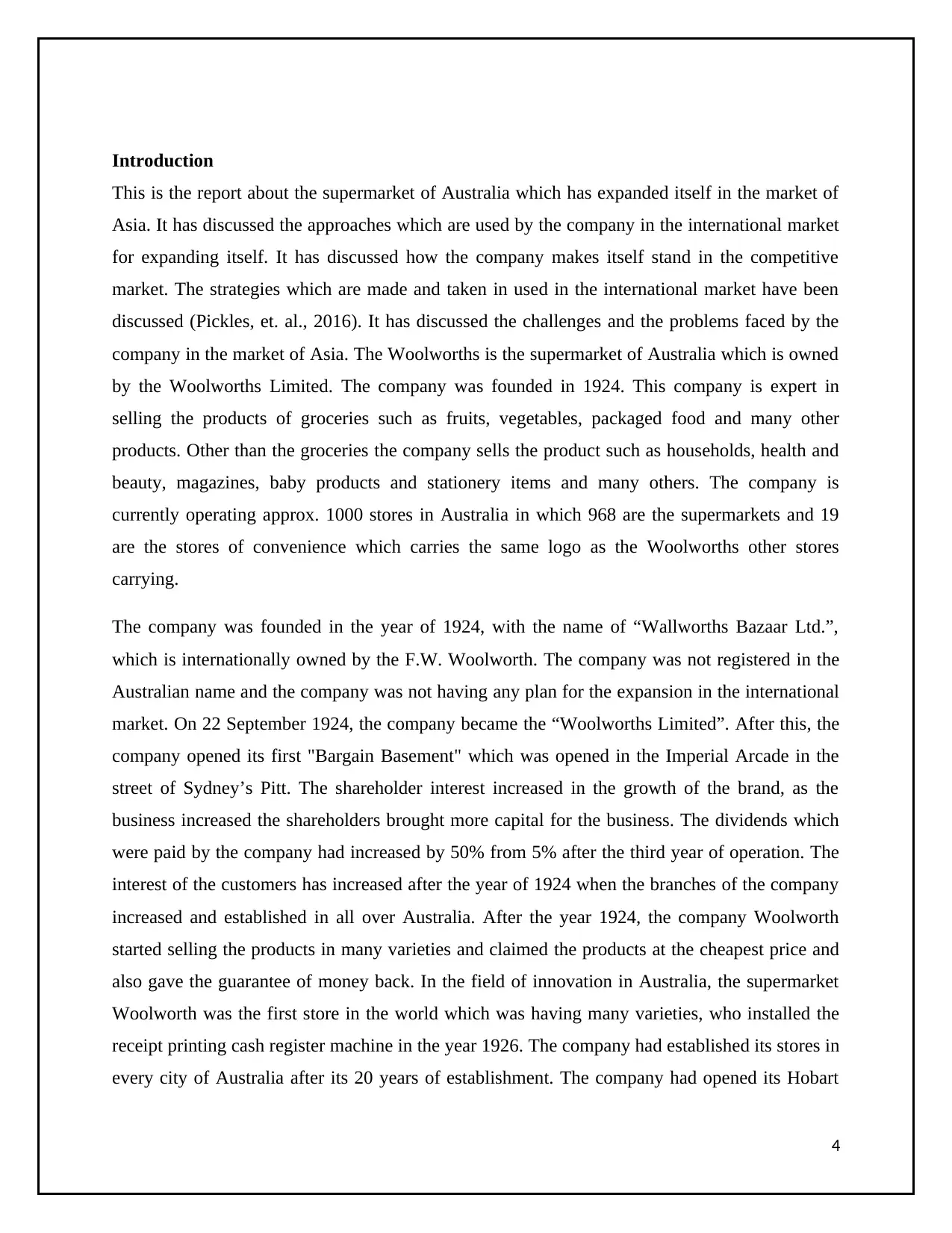
Introduction
This is the report about the supermarket of Australia which has expanded itself in the market of
Asia. It has discussed the approaches which are used by the company in the international market
for expanding itself. It has discussed how the company makes itself stand in the competitive
market. The strategies which are made and taken in used in the international market have been
discussed (Pickles, et. al., 2016). It has discussed the challenges and the problems faced by the
company in the market of Asia. The Woolworths is the supermarket of Australia which is owned
by the Woolworths Limited. The company was founded in 1924. This company is expert in
selling the products of groceries such as fruits, vegetables, packaged food and many other
products. Other than the groceries the company sells the product such as households, health and
beauty, magazines, baby products and stationery items and many others. The company is
currently operating approx. 1000 stores in Australia in which 968 are the supermarkets and 19
are the stores of convenience which carries the same logo as the Woolworths other stores
carrying.
The company was founded in the year of 1924, with the name of “Wallworths Bazaar Ltd.”,
which is internationally owned by the F.W. Woolworth. The company was not registered in the
Australian name and the company was not having any plan for the expansion in the international
market. On 22 September 1924, the company became the “Woolworths Limited”. After this, the
company opened its first "Bargain Basement" which was opened in the Imperial Arcade in the
street of Sydney’s Pitt. The shareholder interest increased in the growth of the brand, as the
business increased the shareholders brought more capital for the business. The dividends which
were paid by the company had increased by 50% from 5% after the third year of operation. The
interest of the customers has increased after the year of 1924 when the branches of the company
increased and established in all over Australia. After the year 1924, the company Woolworth
started selling the products in many varieties and claimed the products at the cheapest price and
also gave the guarantee of money back. In the field of innovation in Australia, the supermarket
Woolworth was the first store in the world which was having many varieties, who installed the
receipt printing cash register machine in the year 1926. The company had established its stores in
every city of Australia after its 20 years of establishment. The company had opened its Hobart
4
This is the report about the supermarket of Australia which has expanded itself in the market of
Asia. It has discussed the approaches which are used by the company in the international market
for expanding itself. It has discussed how the company makes itself stand in the competitive
market. The strategies which are made and taken in used in the international market have been
discussed (Pickles, et. al., 2016). It has discussed the challenges and the problems faced by the
company in the market of Asia. The Woolworths is the supermarket of Australia which is owned
by the Woolworths Limited. The company was founded in 1924. This company is expert in
selling the products of groceries such as fruits, vegetables, packaged food and many other
products. Other than the groceries the company sells the product such as households, health and
beauty, magazines, baby products and stationery items and many others. The company is
currently operating approx. 1000 stores in Australia in which 968 are the supermarkets and 19
are the stores of convenience which carries the same logo as the Woolworths other stores
carrying.
The company was founded in the year of 1924, with the name of “Wallworths Bazaar Ltd.”,
which is internationally owned by the F.W. Woolworth. The company was not registered in the
Australian name and the company was not having any plan for the expansion in the international
market. On 22 September 1924, the company became the “Woolworths Limited”. After this, the
company opened its first "Bargain Basement" which was opened in the Imperial Arcade in the
street of Sydney’s Pitt. The shareholder interest increased in the growth of the brand, as the
business increased the shareholders brought more capital for the business. The dividends which
were paid by the company had increased by 50% from 5% after the third year of operation. The
interest of the customers has increased after the year of 1924 when the branches of the company
increased and established in all over Australia. After the year 1924, the company Woolworth
started selling the products in many varieties and claimed the products at the cheapest price and
also gave the guarantee of money back. In the field of innovation in Australia, the supermarket
Woolworth was the first store in the world which was having many varieties, who installed the
receipt printing cash register machine in the year 1926. The company had established its stores in
every city of Australia after its 20 years of establishment. The company had opened its Hobart
4
Paraphrase This Document
Need a fresh take? Get an instant paraphrase of this document with our AI Paraphraser
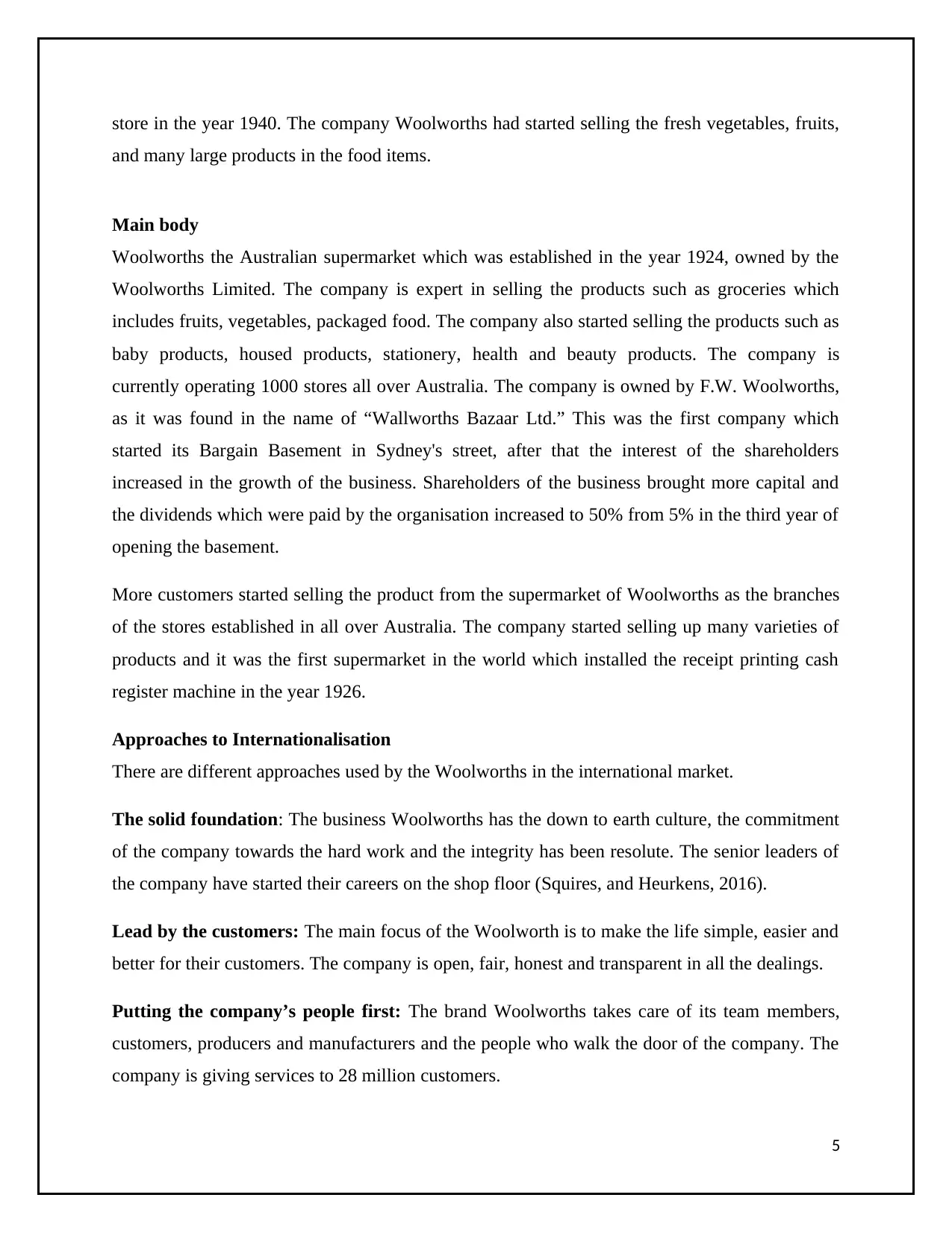
store in the year 1940. The company Woolworths had started selling the fresh vegetables, fruits,
and many large products in the food items.
Main body
Woolworths the Australian supermarket which was established in the year 1924, owned by the
Woolworths Limited. The company is expert in selling the products such as groceries which
includes fruits, vegetables, packaged food. The company also started selling the products such as
baby products, housed products, stationery, health and beauty products. The company is
currently operating 1000 stores all over Australia. The company is owned by F.W. Woolworths,
as it was found in the name of “Wallworths Bazaar Ltd.” This was the first company which
started its Bargain Basement in Sydney's street, after that the interest of the shareholders
increased in the growth of the business. Shareholders of the business brought more capital and
the dividends which were paid by the organisation increased to 50% from 5% in the third year of
opening the basement.
More customers started selling the product from the supermarket of Woolworths as the branches
of the stores established in all over Australia. The company started selling up many varieties of
products and it was the first supermarket in the world which installed the receipt printing cash
register machine in the year 1926.
Approaches to Internationalisation
There are different approaches used by the Woolworths in the international market.
The solid foundation: The business Woolworths has the down to earth culture, the commitment
of the company towards the hard work and the integrity has been resolute. The senior leaders of
the company have started their careers on the shop floor (Squires, and Heurkens, 2016).
Lead by the customers: The main focus of the Woolworth is to make the life simple, easier and
better for their customers. The company is open, fair, honest and transparent in all the dealings.
Putting the company’s people first: The brand Woolworths takes care of its team members,
customers, producers and manufacturers and the people who walk the door of the company. The
company is giving services to 28 million customers.
5
and many large products in the food items.
Main body
Woolworths the Australian supermarket which was established in the year 1924, owned by the
Woolworths Limited. The company is expert in selling the products such as groceries which
includes fruits, vegetables, packaged food. The company also started selling the products such as
baby products, housed products, stationery, health and beauty products. The company is
currently operating 1000 stores all over Australia. The company is owned by F.W. Woolworths,
as it was found in the name of “Wallworths Bazaar Ltd.” This was the first company which
started its Bargain Basement in Sydney's street, after that the interest of the shareholders
increased in the growth of the business. Shareholders of the business brought more capital and
the dividends which were paid by the organisation increased to 50% from 5% in the third year of
opening the basement.
More customers started selling the product from the supermarket of Woolworths as the branches
of the stores established in all over Australia. The company started selling up many varieties of
products and it was the first supermarket in the world which installed the receipt printing cash
register machine in the year 1926.
Approaches to Internationalisation
There are different approaches used by the Woolworths in the international market.
The solid foundation: The business Woolworths has the down to earth culture, the commitment
of the company towards the hard work and the integrity has been resolute. The senior leaders of
the company have started their careers on the shop floor (Squires, and Heurkens, 2016).
Lead by the customers: The main focus of the Woolworth is to make the life simple, easier and
better for their customers. The company is open, fair, honest and transparent in all the dealings.
Putting the company’s people first: The brand Woolworths takes care of its team members,
customers, producers and manufacturers and the people who walk the door of the company. The
company is giving services to 28 million customers.
5
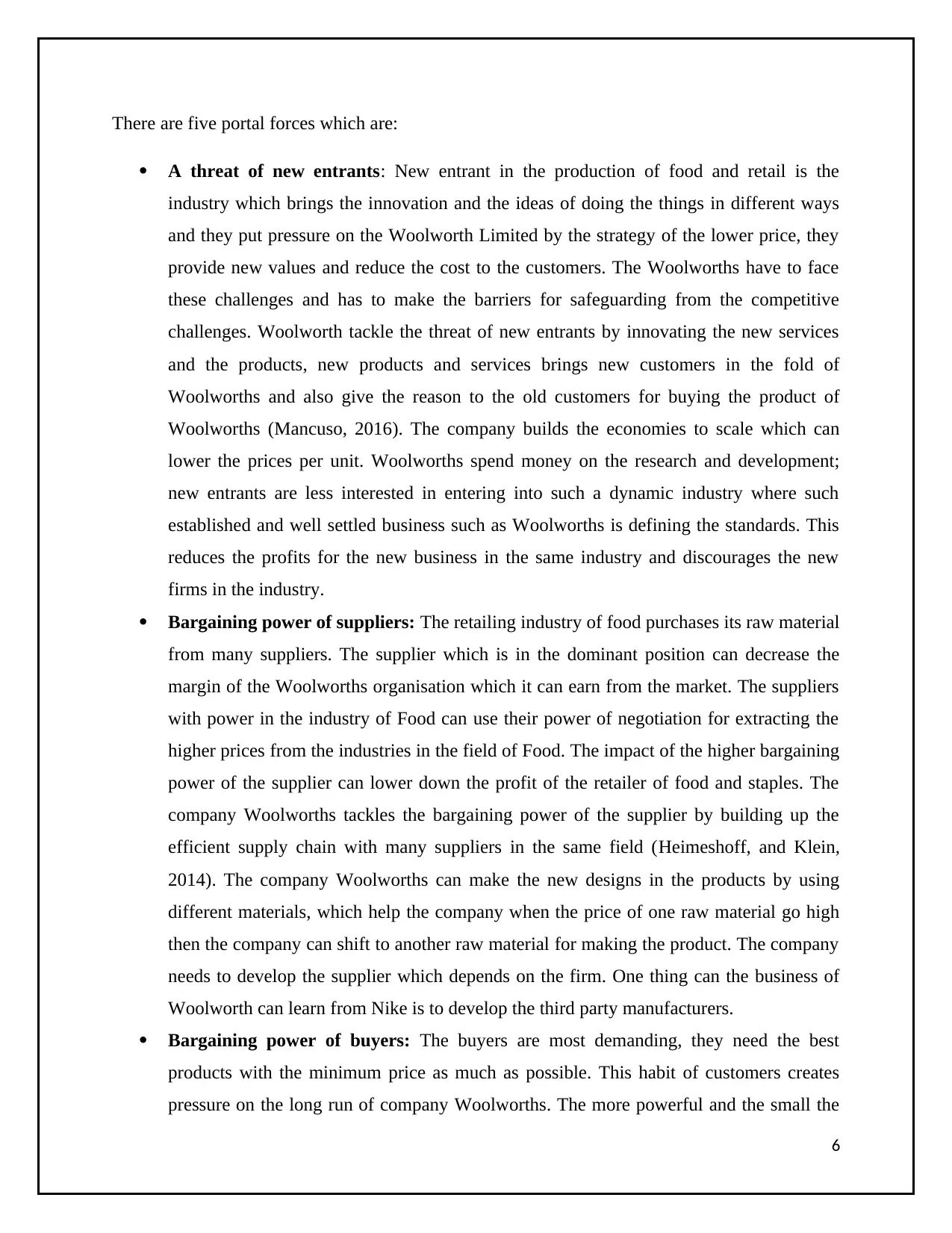
There are five portal forces which are:
A threat of new entrants: New entrant in the production of food and retail is the
industry which brings the innovation and the ideas of doing the things in different ways
and they put pressure on the Woolworth Limited by the strategy of the lower price, they
provide new values and reduce the cost to the customers. The Woolworths have to face
these challenges and has to make the barriers for safeguarding from the competitive
challenges. Woolworth tackle the threat of new entrants by innovating the new services
and the products, new products and services brings new customers in the fold of
Woolworths and also give the reason to the old customers for buying the product of
Woolworths (Mancuso, 2016). The company builds the economies to scale which can
lower the prices per unit. Woolworths spend money on the research and development;
new entrants are less interested in entering into such a dynamic industry where such
established and well settled business such as Woolworths is defining the standards. This
reduces the profits for the new business in the same industry and discourages the new
firms in the industry.
Bargaining power of suppliers: The retailing industry of food purchases its raw material
from many suppliers. The supplier which is in the dominant position can decrease the
margin of the Woolworths organisation which it can earn from the market. The suppliers
with power in the industry of Food can use their power of negotiation for extracting the
higher prices from the industries in the field of Food. The impact of the higher bargaining
power of the supplier can lower down the profit of the retailer of food and staples. The
company Woolworths tackles the bargaining power of the supplier by building up the
efficient supply chain with many suppliers in the same field (Heimeshoff, and Klein,
2014). The company Woolworths can make the new designs in the products by using
different materials, which help the company when the price of one raw material go high
then the company can shift to another raw material for making the product. The company
needs to develop the supplier which depends on the firm. One thing can the business of
Woolworth can learn from Nike is to develop the third party manufacturers.
Bargaining power of buyers: The buyers are most demanding, they need the best
products with the minimum price as much as possible. This habit of customers creates
pressure on the long run of company Woolworths. The more powerful and the small the
6
A threat of new entrants: New entrant in the production of food and retail is the
industry which brings the innovation and the ideas of doing the things in different ways
and they put pressure on the Woolworth Limited by the strategy of the lower price, they
provide new values and reduce the cost to the customers. The Woolworths have to face
these challenges and has to make the barriers for safeguarding from the competitive
challenges. Woolworth tackle the threat of new entrants by innovating the new services
and the products, new products and services brings new customers in the fold of
Woolworths and also give the reason to the old customers for buying the product of
Woolworths (Mancuso, 2016). The company builds the economies to scale which can
lower the prices per unit. Woolworths spend money on the research and development;
new entrants are less interested in entering into such a dynamic industry where such
established and well settled business such as Woolworths is defining the standards. This
reduces the profits for the new business in the same industry and discourages the new
firms in the industry.
Bargaining power of suppliers: The retailing industry of food purchases its raw material
from many suppliers. The supplier which is in the dominant position can decrease the
margin of the Woolworths organisation which it can earn from the market. The suppliers
with power in the industry of Food can use their power of negotiation for extracting the
higher prices from the industries in the field of Food. The impact of the higher bargaining
power of the supplier can lower down the profit of the retailer of food and staples. The
company Woolworths tackles the bargaining power of the supplier by building up the
efficient supply chain with many suppliers in the same field (Heimeshoff, and Klein,
2014). The company Woolworths can make the new designs in the products by using
different materials, which help the company when the price of one raw material go high
then the company can shift to another raw material for making the product. The company
needs to develop the supplier which depends on the firm. One thing can the business of
Woolworth can learn from Nike is to develop the third party manufacturers.
Bargaining power of buyers: The buyers are most demanding, they need the best
products with the minimum price as much as possible. This habit of customers creates
pressure on the long run of company Woolworths. The more powerful and the small the
6
⊘ This is a preview!⊘
Do you want full access?
Subscribe today to unlock all pages.

Trusted by 1+ million students worldwide
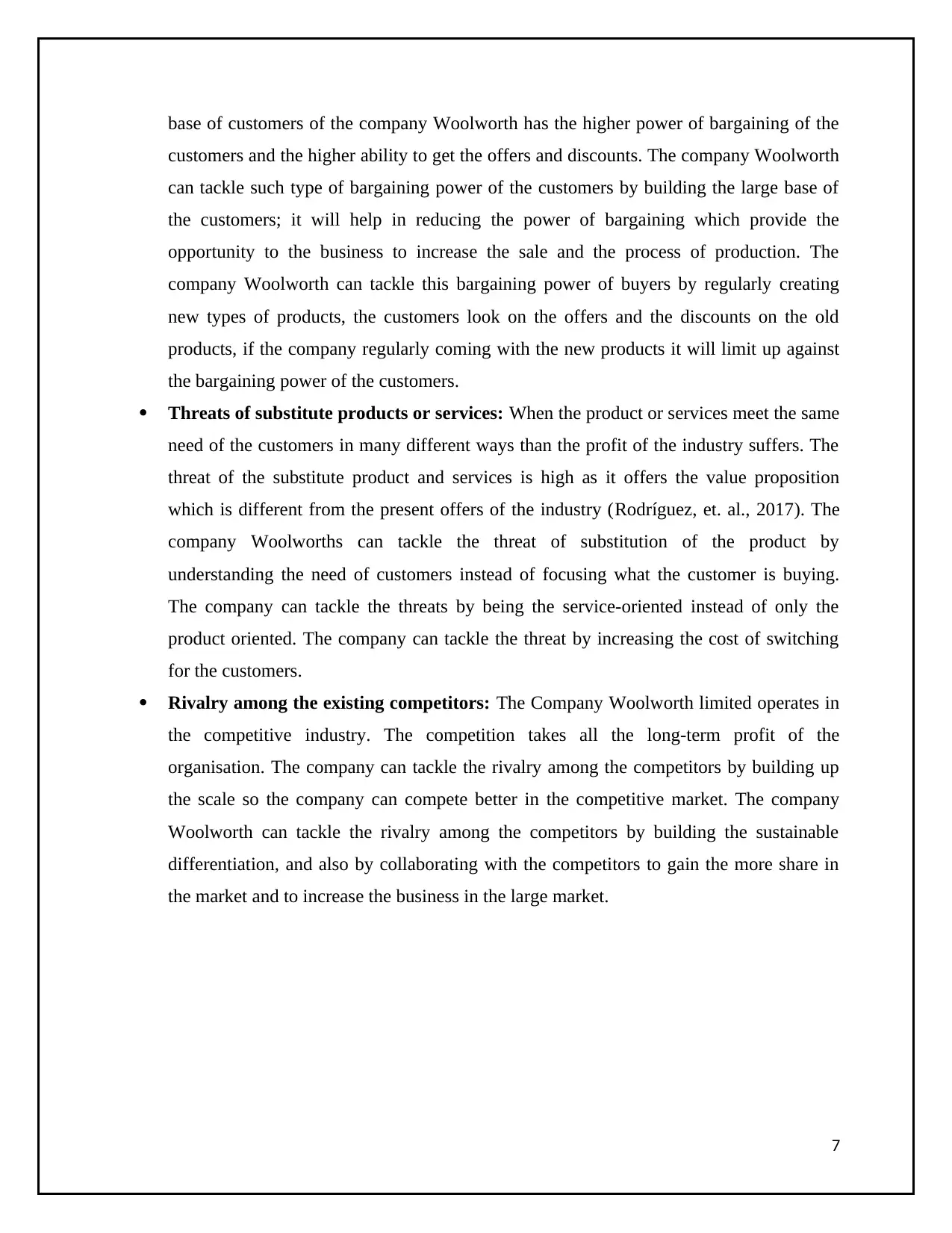
base of customers of the company Woolworth has the higher power of bargaining of the
customers and the higher ability to get the offers and discounts. The company Woolworth
can tackle such type of bargaining power of the customers by building the large base of
the customers; it will help in reducing the power of bargaining which provide the
opportunity to the business to increase the sale and the process of production. The
company Woolworth can tackle this bargaining power of buyers by regularly creating
new types of products, the customers look on the offers and the discounts on the old
products, if the company regularly coming with the new products it will limit up against
the bargaining power of the customers.
Threats of substitute products or services: When the product or services meet the same
need of the customers in many different ways than the profit of the industry suffers. The
threat of the substitute product and services is high as it offers the value proposition
which is different from the present offers of the industry (Rodríguez, et. al., 2017). The
company Woolworths can tackle the threat of substitution of the product by
understanding the need of customers instead of focusing what the customer is buying.
The company can tackle the threats by being the service-oriented instead of only the
product oriented. The company can tackle the threat by increasing the cost of switching
for the customers.
Rivalry among the existing competitors: The Company Woolworth limited operates in
the competitive industry. The competition takes all the long-term profit of the
organisation. The company can tackle the rivalry among the competitors by building up
the scale so the company can compete better in the competitive market. The company
Woolworth can tackle the rivalry among the competitors by building the sustainable
differentiation, and also by collaborating with the competitors to gain the more share in
the market and to increase the business in the large market.
7
customers and the higher ability to get the offers and discounts. The company Woolworth
can tackle such type of bargaining power of the customers by building the large base of
the customers; it will help in reducing the power of bargaining which provide the
opportunity to the business to increase the sale and the process of production. The
company Woolworth can tackle this bargaining power of buyers by regularly creating
new types of products, the customers look on the offers and the discounts on the old
products, if the company regularly coming with the new products it will limit up against
the bargaining power of the customers.
Threats of substitute products or services: When the product or services meet the same
need of the customers in many different ways than the profit of the industry suffers. The
threat of the substitute product and services is high as it offers the value proposition
which is different from the present offers of the industry (Rodríguez, et. al., 2017). The
company Woolworths can tackle the threat of substitution of the product by
understanding the need of customers instead of focusing what the customer is buying.
The company can tackle the threats by being the service-oriented instead of only the
product oriented. The company can tackle the threat by increasing the cost of switching
for the customers.
Rivalry among the existing competitors: The Company Woolworth limited operates in
the competitive industry. The competition takes all the long-term profit of the
organisation. The company can tackle the rivalry among the competitors by building up
the scale so the company can compete better in the competitive market. The company
Woolworth can tackle the rivalry among the competitors by building the sustainable
differentiation, and also by collaborating with the competitors to gain the more share in
the market and to increase the business in the large market.
7
Paraphrase This Document
Need a fresh take? Get an instant paraphrase of this document with our AI Paraphraser
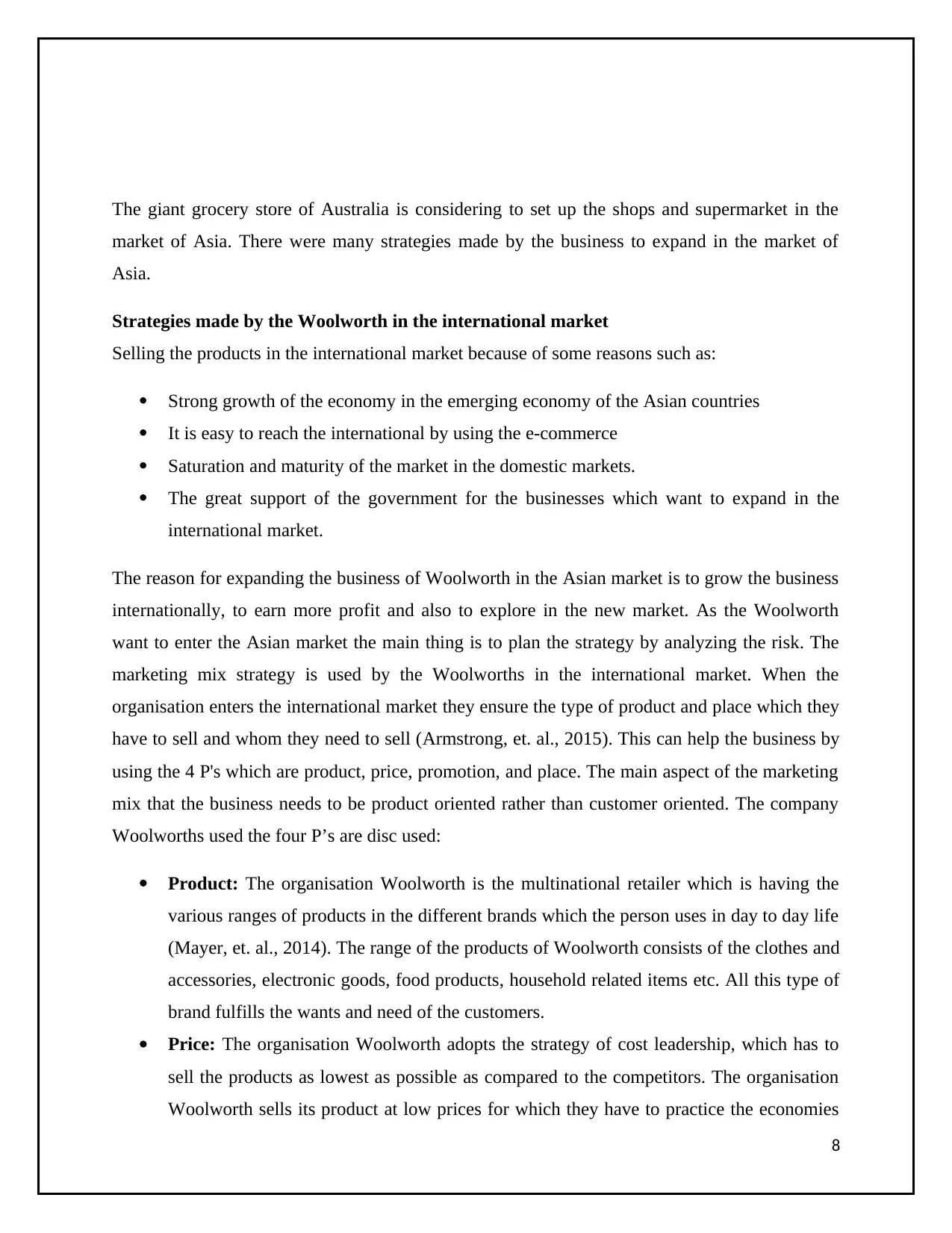
The giant grocery store of Australia is considering to set up the shops and supermarket in the
market of Asia. There were many strategies made by the business to expand in the market of
Asia.
Strategies made by the Woolworth in the international market
Selling the products in the international market because of some reasons such as:
Strong growth of the economy in the emerging economy of the Asian countries
It is easy to reach the international by using the e-commerce
Saturation and maturity of the market in the domestic markets.
The great support of the government for the businesses which want to expand in the
international market.
The reason for expanding the business of Woolworth in the Asian market is to grow the business
internationally, to earn more profit and also to explore in the new market. As the Woolworth
want to enter the Asian market the main thing is to plan the strategy by analyzing the risk. The
marketing mix strategy is used by the Woolworths in the international market. When the
organisation enters the international market they ensure the type of product and place which they
have to sell and whom they need to sell (Armstrong, et. al., 2015). This can help the business by
using the 4 P's which are product, price, promotion, and place. The main aspect of the marketing
mix that the business needs to be product oriented rather than customer oriented. The company
Woolworths used the four P’s are disc used:
Product: The organisation Woolworth is the multinational retailer which is having the
various ranges of products in the different brands which the person uses in day to day life
(Mayer, et. al., 2014). The range of the products of Woolworth consists of the clothes and
accessories, electronic goods, food products, household related items etc. All this type of
brand fulfills the wants and need of the customers.
Price: The organisation Woolworth adopts the strategy of cost leadership, which has to
sell the products as lowest as possible as compared to the competitors. The organisation
Woolworth sells its product at low prices for which they have to practice the economies
8
market of Asia. There were many strategies made by the business to expand in the market of
Asia.
Strategies made by the Woolworth in the international market
Selling the products in the international market because of some reasons such as:
Strong growth of the economy in the emerging economy of the Asian countries
It is easy to reach the international by using the e-commerce
Saturation and maturity of the market in the domestic markets.
The great support of the government for the businesses which want to expand in the
international market.
The reason for expanding the business of Woolworth in the Asian market is to grow the business
internationally, to earn more profit and also to explore in the new market. As the Woolworth
want to enter the Asian market the main thing is to plan the strategy by analyzing the risk. The
marketing mix strategy is used by the Woolworths in the international market. When the
organisation enters the international market they ensure the type of product and place which they
have to sell and whom they need to sell (Armstrong, et. al., 2015). This can help the business by
using the 4 P's which are product, price, promotion, and place. The main aspect of the marketing
mix that the business needs to be product oriented rather than customer oriented. The company
Woolworths used the four P’s are disc used:
Product: The organisation Woolworth is the multinational retailer which is having the
various ranges of products in the different brands which the person uses in day to day life
(Mayer, et. al., 2014). The range of the products of Woolworth consists of the clothes and
accessories, electronic goods, food products, household related items etc. All this type of
brand fulfills the wants and need of the customers.
Price: The organisation Woolworth adopts the strategy of cost leadership, which has to
sell the products as lowest as possible as compared to the competitors. The organisation
Woolworth sells its product at low prices for which they have to practice the economies
8
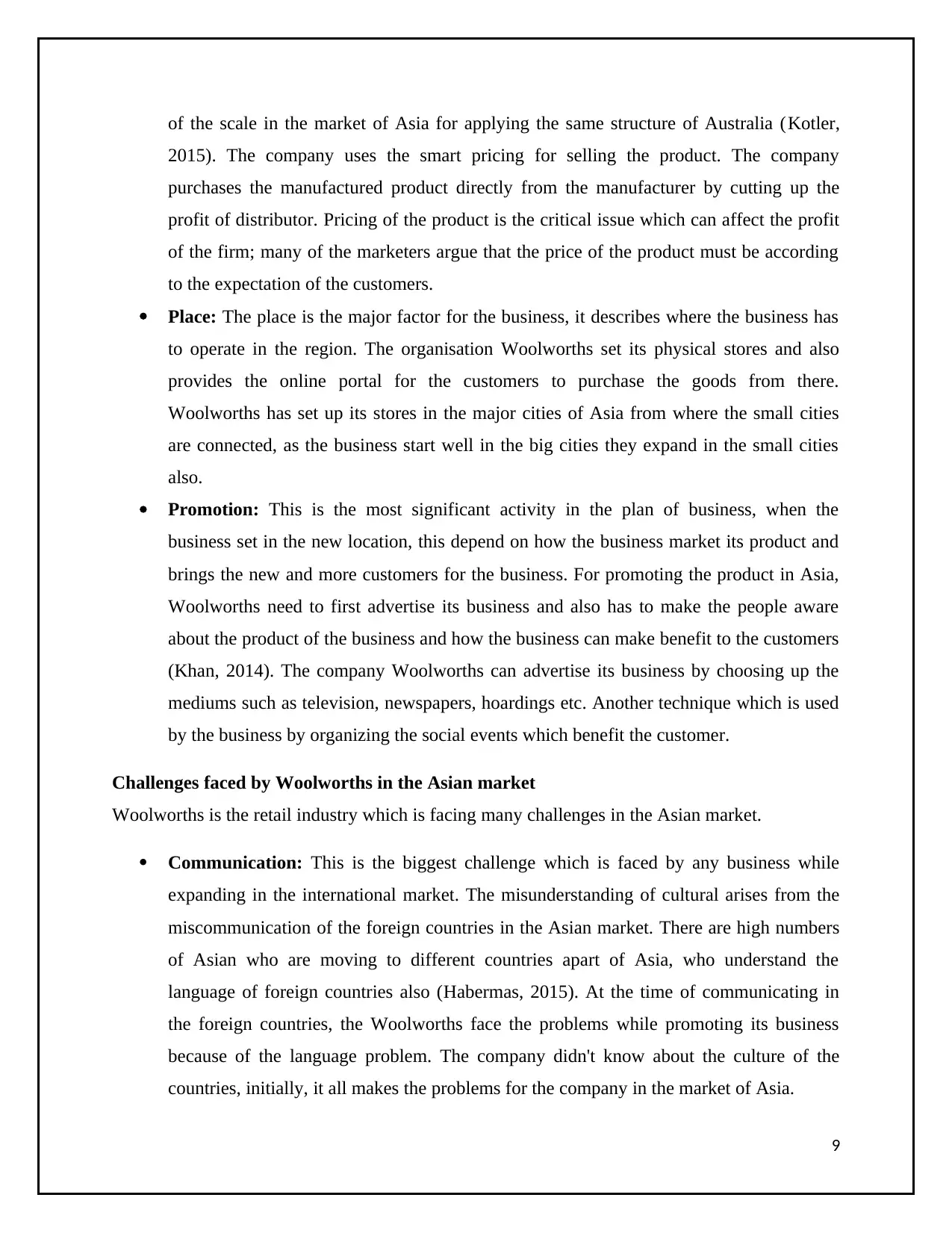
of the scale in the market of Asia for applying the same structure of Australia (Kotler,
2015). The company uses the smart pricing for selling the product. The company
purchases the manufactured product directly from the manufacturer by cutting up the
profit of distributor. Pricing of the product is the critical issue which can affect the profit
of the firm; many of the marketers argue that the price of the product must be according
to the expectation of the customers.
Place: The place is the major factor for the business, it describes where the business has
to operate in the region. The organisation Woolworths set its physical stores and also
provides the online portal for the customers to purchase the goods from there.
Woolworths has set up its stores in the major cities of Asia from where the small cities
are connected, as the business start well in the big cities they expand in the small cities
also.
Promotion: This is the most significant activity in the plan of business, when the
business set in the new location, this depend on how the business market its product and
brings the new and more customers for the business. For promoting the product in Asia,
Woolworths need to first advertise its business and also has to make the people aware
about the product of the business and how the business can make benefit to the customers
(Khan, 2014). The company Woolworths can advertise its business by choosing up the
mediums such as television, newspapers, hoardings etc. Another technique which is used
by the business by organizing the social events which benefit the customer.
Challenges faced by Woolworths in the Asian market
Woolworths is the retail industry which is facing many challenges in the Asian market.
Communication: This is the biggest challenge which is faced by any business while
expanding in the international market. The misunderstanding of cultural arises from the
miscommunication of the foreign countries in the Asian market. There are high numbers
of Asian who are moving to different countries apart of Asia, who understand the
language of foreign countries also (Habermas, 2015). At the time of communicating in
the foreign countries, the Woolworths face the problems while promoting its business
because of the language problem. The company didn't know about the culture of the
countries, initially, it all makes the problems for the company in the market of Asia.
9
2015). The company uses the smart pricing for selling the product. The company
purchases the manufactured product directly from the manufacturer by cutting up the
profit of distributor. Pricing of the product is the critical issue which can affect the profit
of the firm; many of the marketers argue that the price of the product must be according
to the expectation of the customers.
Place: The place is the major factor for the business, it describes where the business has
to operate in the region. The organisation Woolworths set its physical stores and also
provides the online portal for the customers to purchase the goods from there.
Woolworths has set up its stores in the major cities of Asia from where the small cities
are connected, as the business start well in the big cities they expand in the small cities
also.
Promotion: This is the most significant activity in the plan of business, when the
business set in the new location, this depend on how the business market its product and
brings the new and more customers for the business. For promoting the product in Asia,
Woolworths need to first advertise its business and also has to make the people aware
about the product of the business and how the business can make benefit to the customers
(Khan, 2014). The company Woolworths can advertise its business by choosing up the
mediums such as television, newspapers, hoardings etc. Another technique which is used
by the business by organizing the social events which benefit the customer.
Challenges faced by Woolworths in the Asian market
Woolworths is the retail industry which is facing many challenges in the Asian market.
Communication: This is the biggest challenge which is faced by any business while
expanding in the international market. The misunderstanding of cultural arises from the
miscommunication of the foreign countries in the Asian market. There are high numbers
of Asian who are moving to different countries apart of Asia, who understand the
language of foreign countries also (Habermas, 2015). At the time of communicating in
the foreign countries, the Woolworths face the problems while promoting its business
because of the language problem. The company didn't know about the culture of the
countries, initially, it all makes the problems for the company in the market of Asia.
9
⊘ This is a preview!⊘
Do you want full access?
Subscribe today to unlock all pages.

Trusted by 1+ million students worldwide
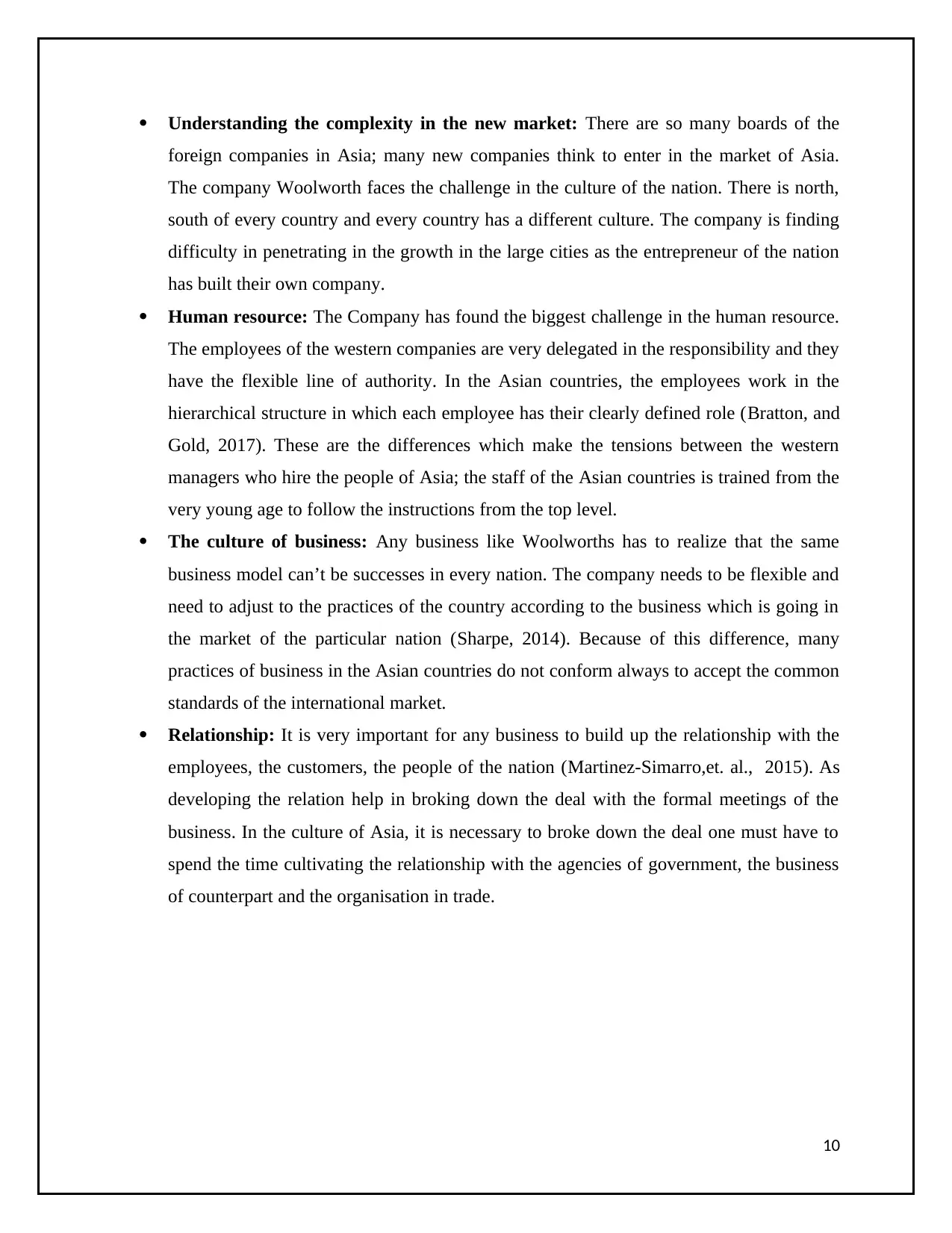
Understanding the complexity in the new market: There are so many boards of the
foreign companies in Asia; many new companies think to enter in the market of Asia.
The company Woolworth faces the challenge in the culture of the nation. There is north,
south of every country and every country has a different culture. The company is finding
difficulty in penetrating in the growth in the large cities as the entrepreneur of the nation
has built their own company.
Human resource: The Company has found the biggest challenge in the human resource.
The employees of the western companies are very delegated in the responsibility and they
have the flexible line of authority. In the Asian countries, the employees work in the
hierarchical structure in which each employee has their clearly defined role (Bratton, and
Gold, 2017). These are the differences which make the tensions between the western
managers who hire the people of Asia; the staff of the Asian countries is trained from the
very young age to follow the instructions from the top level.
The culture of business: Any business like Woolworths has to realize that the same
business model can’t be successes in every nation. The company needs to be flexible and
need to adjust to the practices of the country according to the business which is going in
the market of the particular nation (Sharpe, 2014). Because of this difference, many
practices of business in the Asian countries do not conform always to accept the common
standards of the international market.
Relationship: It is very important for any business to build up the relationship with the
employees, the customers, the people of the nation (Martinez-Simarro,et. al., 2015). As
developing the relation help in broking down the deal with the formal meetings of the
business. In the culture of Asia, it is necessary to broke down the deal one must have to
spend the time cultivating the relationship with the agencies of government, the business
of counterpart and the organisation in trade.
10
foreign companies in Asia; many new companies think to enter in the market of Asia.
The company Woolworth faces the challenge in the culture of the nation. There is north,
south of every country and every country has a different culture. The company is finding
difficulty in penetrating in the growth in the large cities as the entrepreneur of the nation
has built their own company.
Human resource: The Company has found the biggest challenge in the human resource.
The employees of the western companies are very delegated in the responsibility and they
have the flexible line of authority. In the Asian countries, the employees work in the
hierarchical structure in which each employee has their clearly defined role (Bratton, and
Gold, 2017). These are the differences which make the tensions between the western
managers who hire the people of Asia; the staff of the Asian countries is trained from the
very young age to follow the instructions from the top level.
The culture of business: Any business like Woolworths has to realize that the same
business model can’t be successes in every nation. The company needs to be flexible and
need to adjust to the practices of the country according to the business which is going in
the market of the particular nation (Sharpe, 2014). Because of this difference, many
practices of business in the Asian countries do not conform always to accept the common
standards of the international market.
Relationship: It is very important for any business to build up the relationship with the
employees, the customers, the people of the nation (Martinez-Simarro,et. al., 2015). As
developing the relation help in broking down the deal with the formal meetings of the
business. In the culture of Asia, it is necessary to broke down the deal one must have to
spend the time cultivating the relationship with the agencies of government, the business
of counterpart and the organisation in trade.
10
Paraphrase This Document
Need a fresh take? Get an instant paraphrase of this document with our AI Paraphraser
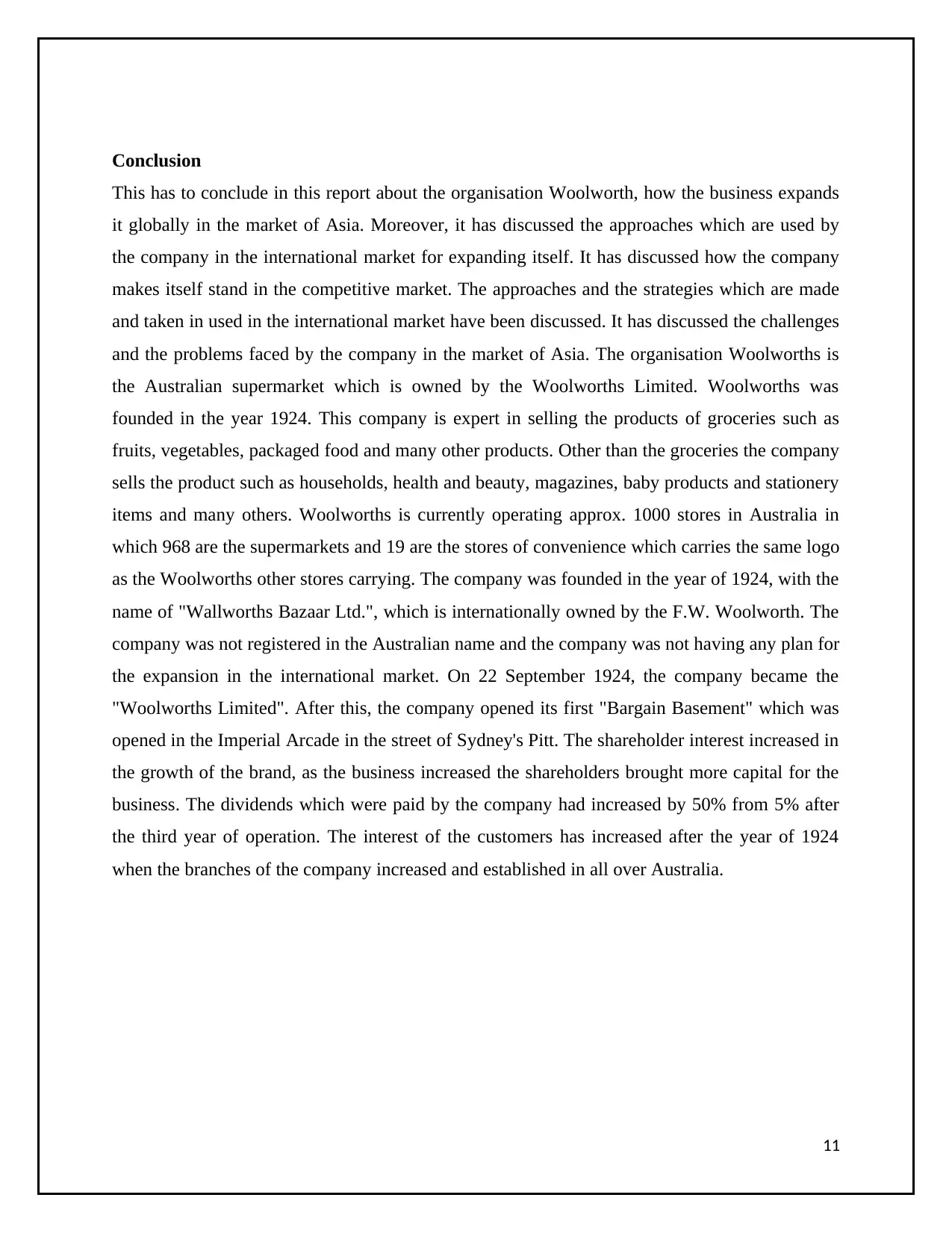
Conclusion
This has to conclude in this report about the organisation Woolworth, how the business expands
it globally in the market of Asia. Moreover, it has discussed the approaches which are used by
the company in the international market for expanding itself. It has discussed how the company
makes itself stand in the competitive market. The approaches and the strategies which are made
and taken in used in the international market have been discussed. It has discussed the challenges
and the problems faced by the company in the market of Asia. The organisation Woolworths is
the Australian supermarket which is owned by the Woolworths Limited. Woolworths was
founded in the year 1924. This company is expert in selling the products of groceries such as
fruits, vegetables, packaged food and many other products. Other than the groceries the company
sells the product such as households, health and beauty, magazines, baby products and stationery
items and many others. Woolworths is currently operating approx. 1000 stores in Australia in
which 968 are the supermarkets and 19 are the stores of convenience which carries the same logo
as the Woolworths other stores carrying. The company was founded in the year of 1924, with the
name of "Wallworths Bazaar Ltd.", which is internationally owned by the F.W. Woolworth. The
company was not registered in the Australian name and the company was not having any plan for
the expansion in the international market. On 22 September 1924, the company became the
"Woolworths Limited". After this, the company opened its first "Bargain Basement" which was
opened in the Imperial Arcade in the street of Sydney's Pitt. The shareholder interest increased in
the growth of the brand, as the business increased the shareholders brought more capital for the
business. The dividends which were paid by the company had increased by 50% from 5% after
the third year of operation. The interest of the customers has increased after the year of 1924
when the branches of the company increased and established in all over Australia.
11
This has to conclude in this report about the organisation Woolworth, how the business expands
it globally in the market of Asia. Moreover, it has discussed the approaches which are used by
the company in the international market for expanding itself. It has discussed how the company
makes itself stand in the competitive market. The approaches and the strategies which are made
and taken in used in the international market have been discussed. It has discussed the challenges
and the problems faced by the company in the market of Asia. The organisation Woolworths is
the Australian supermarket which is owned by the Woolworths Limited. Woolworths was
founded in the year 1924. This company is expert in selling the products of groceries such as
fruits, vegetables, packaged food and many other products. Other than the groceries the company
sells the product such as households, health and beauty, magazines, baby products and stationery
items and many others. Woolworths is currently operating approx. 1000 stores in Australia in
which 968 are the supermarkets and 19 are the stores of convenience which carries the same logo
as the Woolworths other stores carrying. The company was founded in the year of 1924, with the
name of "Wallworths Bazaar Ltd.", which is internationally owned by the F.W. Woolworth. The
company was not registered in the Australian name and the company was not having any plan for
the expansion in the international market. On 22 September 1924, the company became the
"Woolworths Limited". After this, the company opened its first "Bargain Basement" which was
opened in the Imperial Arcade in the street of Sydney's Pitt. The shareholder interest increased in
the growth of the brand, as the business increased the shareholders brought more capital for the
business. The dividends which were paid by the company had increased by 50% from 5% after
the third year of operation. The interest of the customers has increased after the year of 1924
when the branches of the company increased and established in all over Australia.
11
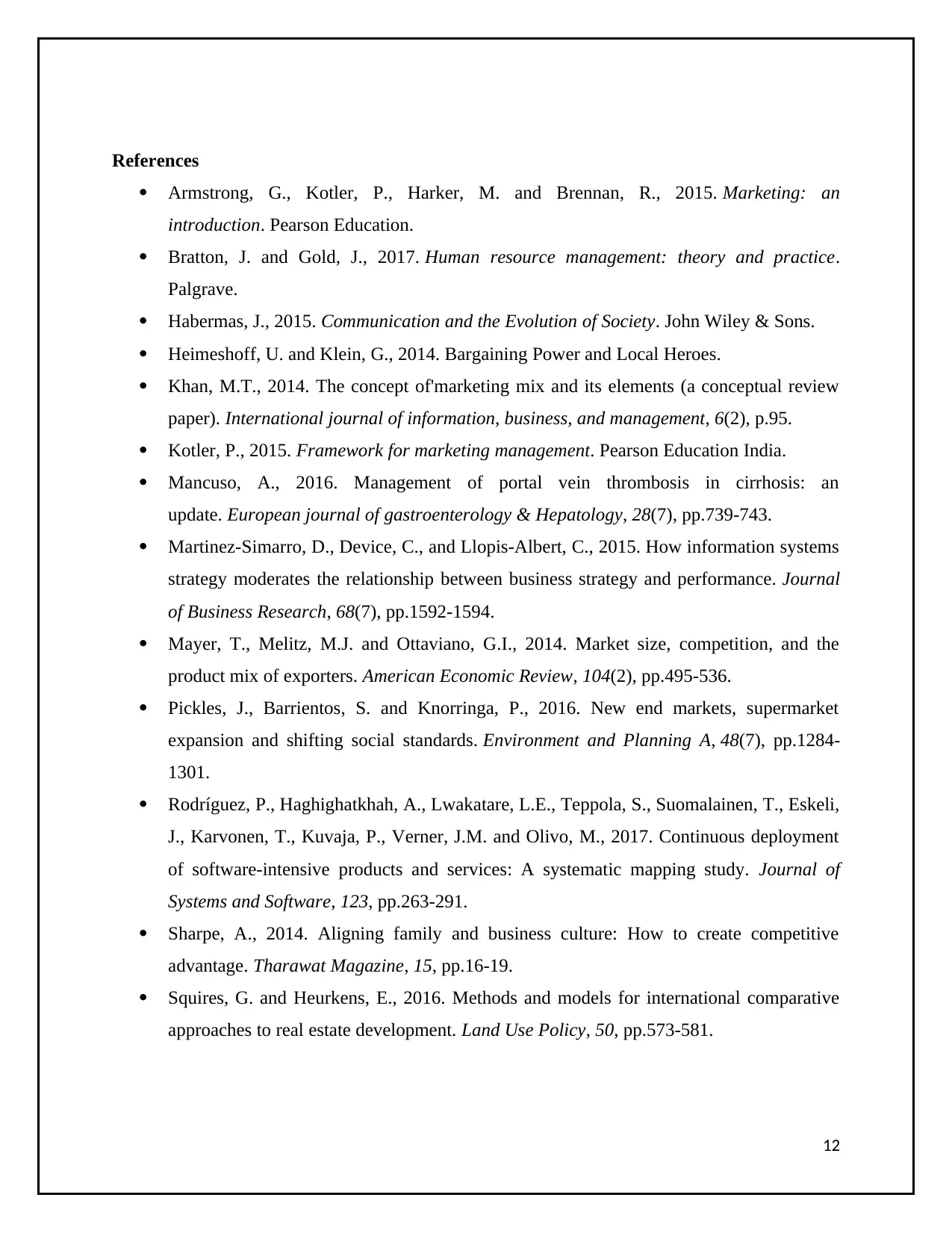
References
Armstrong, G., Kotler, P., Harker, M. and Brennan, R., 2015. Marketing: an
introduction. Pearson Education.
Bratton, J. and Gold, J., 2017. Human resource management: theory and practice.
Palgrave.
Habermas, J., 2015. Communication and the Evolution of Society. John Wiley & Sons.
Heimeshoff, U. and Klein, G., 2014. Bargaining Power and Local Heroes.
Khan, M.T., 2014. The concept of'marketing mix and its elements (a conceptual review
paper). International journal of information, business, and management, 6(2), p.95.
Kotler, P., 2015. Framework for marketing management. Pearson Education India.
Mancuso, A., 2016. Management of portal vein thrombosis in cirrhosis: an
update. European journal of gastroenterology & Hepatology, 28(7), pp.739-743.
Martinez-Simarro, D., Device, C., and Llopis-Albert, C., 2015. How information systems
strategy moderates the relationship between business strategy and performance. Journal
of Business Research, 68(7), pp.1592-1594.
Mayer, T., Melitz, M.J. and Ottaviano, G.I., 2014. Market size, competition, and the
product mix of exporters. American Economic Review, 104(2), pp.495-536.
Pickles, J., Barrientos, S. and Knorringa, P., 2016. New end markets, supermarket
expansion and shifting social standards. Environment and Planning A, 48(7), pp.1284-
1301.
Rodríguez, P., Haghighatkhah, A., Lwakatare, L.E., Teppola, S., Suomalainen, T., Eskeli,
J., Karvonen, T., Kuvaja, P., Verner, J.M. and Olivo, M., 2017. Continuous deployment
of software-intensive products and services: A systematic mapping study. Journal of
Systems and Software, 123, pp.263-291.
Sharpe, A., 2014. Aligning family and business culture: How to create competitive
advantage. Tharawat Magazine, 15, pp.16-19.
Squires, G. and Heurkens, E., 2016. Methods and models for international comparative
approaches to real estate development. Land Use Policy, 50, pp.573-581.
12
Armstrong, G., Kotler, P., Harker, M. and Brennan, R., 2015. Marketing: an
introduction. Pearson Education.
Bratton, J. and Gold, J., 2017. Human resource management: theory and practice.
Palgrave.
Habermas, J., 2015. Communication and the Evolution of Society. John Wiley & Sons.
Heimeshoff, U. and Klein, G., 2014. Bargaining Power and Local Heroes.
Khan, M.T., 2014. The concept of'marketing mix and its elements (a conceptual review
paper). International journal of information, business, and management, 6(2), p.95.
Kotler, P., 2015. Framework for marketing management. Pearson Education India.
Mancuso, A., 2016. Management of portal vein thrombosis in cirrhosis: an
update. European journal of gastroenterology & Hepatology, 28(7), pp.739-743.
Martinez-Simarro, D., Device, C., and Llopis-Albert, C., 2015. How information systems
strategy moderates the relationship between business strategy and performance. Journal
of Business Research, 68(7), pp.1592-1594.
Mayer, T., Melitz, M.J. and Ottaviano, G.I., 2014. Market size, competition, and the
product mix of exporters. American Economic Review, 104(2), pp.495-536.
Pickles, J., Barrientos, S. and Knorringa, P., 2016. New end markets, supermarket
expansion and shifting social standards. Environment and Planning A, 48(7), pp.1284-
1301.
Rodríguez, P., Haghighatkhah, A., Lwakatare, L.E., Teppola, S., Suomalainen, T., Eskeli,
J., Karvonen, T., Kuvaja, P., Verner, J.M. and Olivo, M., 2017. Continuous deployment
of software-intensive products and services: A systematic mapping study. Journal of
Systems and Software, 123, pp.263-291.
Sharpe, A., 2014. Aligning family and business culture: How to create competitive
advantage. Tharawat Magazine, 15, pp.16-19.
Squires, G. and Heurkens, E., 2016. Methods and models for international comparative
approaches to real estate development. Land Use Policy, 50, pp.573-581.
12
⊘ This is a preview!⊘
Do you want full access?
Subscribe today to unlock all pages.

Trusted by 1+ million students worldwide
1 out of 13
Related Documents
Your All-in-One AI-Powered Toolkit for Academic Success.
+13062052269
info@desklib.com
Available 24*7 on WhatsApp / Email
![[object Object]](/_next/static/media/star-bottom.7253800d.svg)
Unlock your academic potential
Copyright © 2020–2025 A2Z Services. All Rights Reserved. Developed and managed by ZUCOL.




